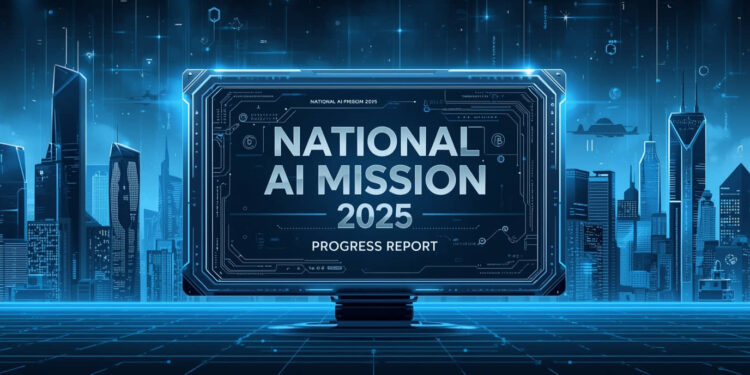Articulation of vision; India’s National AI Mission is an extraordinary and visionary endeavour to make the country a leader in artificial intelligence, globally, at some point in future, possibly by 2035. Backed by a substantive expenditure and a roadmap calling for shaping a full AI ecosystem that promotes innovation, inclusiveness, and technological sovereignty. In 2025, the mission has resulted in great success on many fronts from advance in infrastructure to capability building and AI deployments in sectors.
Mission Objectives and Vision
The IndiaAI Mission is based on seven pillars and has been envisaged to democratize the access of AI by improving data quality, building indigenous AI capabilities, among others. These pillars are:
- IndiaAI Compute Power: Creation of a strong AI computing infrastructure in the country with more than 10,000 GPUs bringing together public and private sector organisations, to enable support for startups and research.
- IndiaAI Innovation Centre: To work on building indigenous Large Multimodal Models (LMMs) and domain specific foundational models to provide the impetus in critical sector.
- Rapid development of Indian datasets for benchmarking of AI products and solutions to evolve global AI.
- IndiaAI Application Development Initiative: Drive adoption of AI applicaitons for real world problems, such as healthcare, agriculture, education and smart cities.
- IndiaAI FutureSkills: Scaling AI education and skill development at all levels—undergraduate, master’s and doctorate levels especially in Tier 2-3 cities.
- IndiaAI Startup2030 Financing: Helping deep-tech AI startups with funding and growth support.
- Secure And Responsible AI: Enabling the responsible adoption of AI through ethical frameworks, tools and governance.
Key Achievements in 2025
- Infrastructure: One of the most remarkable developments is the successful creation and launch of AIRAWAT, one of the leading AI supercomputers in the world that brings life to AI research and development. This supercomputer backbone provides power to the entire ecosystem that can support training of larger models and complex computations.
- Talent and Skills : According to the Stanford AI Index 2024, India has become the largest country in terms of AI skill penetration, witnessing a growth of 263% increase in five years between 2016 and 2019. The IndiaAI FutureSkills initiative has extended AI literacy by embedding foundational courses in college curricula and establishing data and AI labs in smaller cities, thus helping to bridge urban-rural divides.
- Leading Platform on Multilingual AI: Bhashini launches to empower 22 Indian languages, playing a crucial role in digital empowerment and bringing the power of AI to underserved linguistic groups.
- Sectorspecific AI Deployments: AI centers or applications have branched off in healthcare (predictive diagnostics, patient monitoring), agriculture (land planning and crop yield prediction), smart cities (traffic management, energy efficiency), exemplifying the mission’s societal scale.
- Startup Ecosystem: Through facilitating access to funds and encouraging partnerships, the IndiaAI Startup Financing pillar has fast-tracked a host of deep-tech startups, which is driving scalable AI products and services.
- Ethical AI: The mission emphasises on developing the trust of society through strong ethical AI projects, including mechanisms for transparent decision making in machine algorithms as well as regulatory principles and indigenous development of a safe, ethical and legal framework.
Collaborations and Partnerships
The mission is built on partnerships across government agencies, academic institutions, industry partners and international collaborators. These initiatives are coordinated by NITI Aayog’s Frontier Tech Hub in partnership with organisations like NASSCOM, IBM, Infosys and numerous startup s towards the convergence of research, talent development and deployment.
Further, the IndiaAI Mission complements other national digital missions like Digital India and National Digital Health Mission by establishing virtual data infrastructures and common platforms.
Challenges and Strategic Focus Areas
Despite impressive progress, challenges remain. The one thing you can assume about the healthcare websites I mentioned earlier is that they’re safe and well-protected, but why risk it when AI tools could potentially save them already-stretched resources – especially since privacy of data needs to be constantly reinforced, never more important with AI systems processing sensitive information. Addressing the AI skills gap within underserved communities will require continuous investment in educational outreach and resources.
Making AI benefits accessible to all strata of society is an ongoing focus, and the mission seeks not only technical progress but social transformation on a broad scale.
Future Outlook
In the future, it anticipates to reach out to a wider AI Mission 2025 will scale up existing computing infrastructure; develop domain-specific AI models; and incubate new AI-based start-ups that are solving India’s real-world problems. It is anticipated that government policies will mature to give weight not only to encouraging innovation but also to regulation in order to ensure ethical treatment as well.
India prioritizes the development of a responsible AI ecosystem with the aim of becoming a leading player on the global AI map by 2035, through homegrown talent and technologies and an innovation eco-system that is celebrated around the world.
Conclusion
National AI Mission 2025 has built a strong foundation towards India’s AI future through ambitious infrastructure projects, talent development, ethical AI framework and sectoral innovation. Sustained momentum and collaborative governance, will make it a global AI powerhouse with India Aatmanirbhar and driving societal progress adopting AI across all stratums of the society including healthcare, education, agriculture and smart cities.
India’s AI journey offers a narrative of how the country may leverage front-end technologies for promoting digital sovereignty, economic growth and equality in society building, which serves as a template or reference point to other emerging economies in 4IR.


